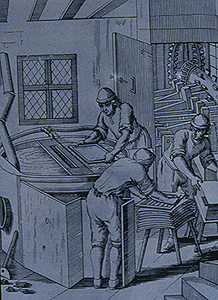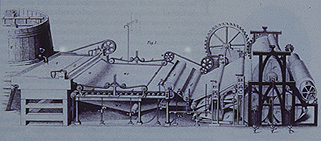
Papermaking
|
|
Paper and board are by far the most common material found in library, archives, and records collections. The invention of paper is credited to the Chinese in 105 AD. The technique gradually spread to Japan, central Asia, and Persia over the next 600 years. The first European hand papermaking mill was established in Spain in the 12th century, and papermaking spread throughout Europe over the next 300 years.
Hand Papermaking
In this process, a fibrous material, such as cotton or wood pulp, is boiled and pressed into a watery pulp. A screen (called a mould) is passed under the pulp to form a mat of fibers, and the resulting sheet of intertwined fibers is pressed between felt sheets to be dried. The sheet is then sized to make the surface suitable for writing, either by coating the paper by hand or dipping it into a tub of sizing solution. Very early papers were often sized with starch; later, gelatin was used.
|
In machine papermaking, pulp is poured |
Machine Papermaking
The papermaking machine was invented in France in the late 18th century, and was further developed in England in the early 19th century by the Fourdrinier brothers, by whose name it is still known. The first Fourdrinier papermaking machine was put into operation in 1804. In machine papermaking, the reduced fibers (pulp) are suspended in water, which is placed in a reservoir; the pulp is poured onto a continuous roll of woven wire mesh that allows the water to drain through; the wire mesh is moved from side to side to form a mat of fibers; and the sheet then runs through a felt roller to dry it. Explore The Wisconsin Paper Council's How Paper Is Made resource for a description of the modern commercial paper-making process. This method has been refined to make it more efficient over the last 200 years, but the essential process remains the same.


